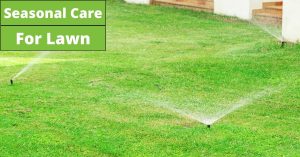Guide for watering lawns – Watering lawns is a very important part of keeping your lawn healthy and green. If you don’t water your lawn, it will dry out quickly and become brown or even die. This guide will help you to understand how to properly water your lawn so that you can get the most from your watering efforts.
Common Lawn Diseases, Pest & Weed Control
Common Lawn Diseases
There are several common lawn diseases that can impact your yard, including:
- Brown Patch: Caused by a number of different fungi, Brown Patch appears as circular patches of blighted turf ranging from 2 to 12 feet in diameter. The grass will turn brown and die, with a patchy or matted appearance.
- Black Spot: This disease is caused by the fungus Diplocarpon rosae and results in small black spots on leaves that gradually enlarge and merge to form large areas of dead grass.
- Powdery Mildew: Appears as a white powder on the surface of infected plants. It can cause leaves to curl up and die, stunt growth, and reduces photosynthesis.
- Fairy Rings: A ring or arc-shaped pattern of dark green turf that is usually about 10 feet wide. The centre may be killed while the outside remains healthy, or vice versa.
Common Lawn Weeds
Weeds are a common nuisance in lawns, and they can take any form. The most popular weeds are broadleaf plants, which may be more difficult to control than other types of pests, such as bugs and rodents. Weed seeds produce large numbers of seeds which help their spread.
Lawn weeds can often be identified by looking at the symptoms. For example, if you see patches of discolouration or thinning grass, this could be a sign that you have a weed problem.
The failure to identify lawns correctly can worsen their ailments, often with the incorrect treatment applied. For instance, compacted soils can be fixed by walking over them with aerator sandals. And leave the lawn mower blades longer to encourage photosynthesis during the shorter days
Common Lawn Pests
There are many different types of pests that can infest your lawn. Ants, moles, armyworms, cutworms, African black beetles, two-spotted mites, white curl grubs, and sod webworms are all common lawn pests.
If you notice any of these pests on your lawn, it’s important to take action and treat the problem as soon as possible. Our guide covers how to treat them with different methods (i.e., pesticides).
White curl grub and black beetle are two common lawn diseases that attack by feeding on the roots of the grass. White curl grub feeds off the roots of your grass, while black beetle damages a lawn by chewing away at patches.
Armyworms feast on your lawn at night so it’s difficult to pin down their exact cause for damage to your lawn. Armyworms can be treated with a pesticide, like Eco Grub 3 in 1 for Lawns and Gardens. Organic alternatives include eco-neem
Seasonal Care For Lawn
Summer Lawn Care
Fertilizing, watering, and mowing are all important components of lawn care in the summer. Pre-planning can help ensure your lawn survives the heat, wind, and dryness it experiences in this season.
A lawn can be very dry in late summer. Water early in the morning, while it’s cool. Late watering may cause overnight humidity and fungal problems. Mowing the lawn in hot, dry weather helps growth slow down so fewer leaves are burned during mowing and promote cooling for the plant’s roots to prevent drought.
Weed watch: Dandelion and cats-ear continue to thrive even during Summer heat waves when other plants might not survive. Scotts Lawn Builder Weed, Feed & Green Up is a perfect choice because it waters as it works. Make sure to read the label before using any lawn care product during hot weather.
Autumn Lawn Care
Autumn is the best time to care for your lawn, as most weeds will be dormant. In order to have a healthy lawn next Spring, it is important to do some Autumn maintenance:
- Aerate the soil – This helps improve drainage and allows air and water to reach the roots.
- Fertilize – A good fertilizer will help the grass resist damage from cold weather.
- Water – Lawns should be watered deeply but infrequently, preferably using a timer or rain gauge so that you don’t overwater.
- Mow – Mowing frequency will decrease as growth slows; raise your mower’s cutting height in order to keep the grass healthy.
- Weed Control – Many common weeds are more susceptible to herbicides in the Fall when they’re actively growing.
- Clean Up Leaves & Debris – Leaving leaves and other debris on your lawn can cause fungal diseases.
Winter Lawn Care
It is important to keep your lawn healthy during winter, even if it goes dormant. You must adjust your water regime during the colder months to allow for adequate hydration of the soil. It is best not to stop caring for your lawn while it hibernates in winter. Not fertilizing your lawn in the Winter is not recommended. Grass growing slower and taking up fewer nutrients means it’s not necessary to feed it during this season; however, watering should be done in the morning regardless of the season. Mowing can only be necessary two or three times over winter, depending on where you are located; in areas, with cold nights it is best to water in the morning before a night frost or freeze will occur.
Weed watch in the winter: bindii and broadleaf weeds. Read the label to make sure your lawn is suitable for treating weed issues before using any herbicides; the most conspicuous weed is likely to be Winter Grass, which will stand out lush and green against dormant grasses. Winter grass can be removed by hand – although this may take some time – as selective lawn weeders will not kill winter grass, so it must be removed manually with a daisy grubber.
Top dressing is the addition of a specially blended mix of materials to the surface of a lawn – Australian Summers are filled with endless hours of fun and games, so keep your lawn healthy during wet weather and see if you can show off your backyard for all to see!
Spring Lawn Care
The soil is starting to warm up, so raking the lawn is a good idea. This will remove any leaves, twigs, or dead grass that have built up over the winter.
Aerating your lawn will help it be strong and healthy for the coming summer months. When you aerate, you’re actually removing plugs of soil from the ground. This helps improve water drainage and allows nutrients and air to reach the roots better.
Watering your lawn in spring helps prepare it for summer grass growth and will prevent weeds from taking over before they’re ready to be killed by pesticides or herbicides. Make sure to give your lawn at least an inch of water per week during this time; more if it’s really hot outside.
- The lawn needs to be raked vigorously to get rid of leaves, twigs, and dead grass. You may also want to consider using a leaf blower instead of a rake – this can save you some time!
- Fertilizing during this time is critical for the lawn’s health; Scotts Lawn Builder + Weedkiller should do just fine. Be sure not to fertilize too much though, as this can cause damage in the long run.
- Mowing is good when it’s done with mulch, instead of a catcher over the mower’s blades. Mulching helps to fertilize the lawn as you mow.
- Now is a time to check your mower’s blades and make sure they’re sharpened or changed to mulch mowing if there was one during winter.
- The lawn must be thick and dense in order to prevent weeds from taking over – Scotts Lawn Builder + Weedkiller can help with this.
- Use Scotts Lawn Builder + Weedkiller instead of All-Purpose if you are dealing with very sparse grass.
- Spring is the time to start lawn care; visit our Spring Lawn Care page for tips on how to take care of your grass during this season and avoid the drought.
A Complete Guide for Watering Lawns
Watering your lawn the right way
Watering your lawn is an important part of taking care of it. The right way to water will help your lawn stay healthy and look good.
You should water your lawn twice a day for the first two weeks. This will help the roots get established in the soil. After that, you can water once a day, unless there is high humidity or it’s nighttime.
The best time to water is early in the morning when the sun is out and the temperature is warm. You should not water your lawn during nighttime or on a day with high humidity. When watering, it’s best to wet the soil several inches down rather than just one inch, so that more of the moisture has a chance to soak into the ground. Deep roots help a lawn survive drought conditions.
Some cities and municipalities have restrictions on when or how frequent watering should take place. Be sure to check with your local government before watering your lawn!
How often to water your lawn
It is best to water your lawn early in the morning so that the water has time to be absorbed by the soil. If you water during the day, make sure to avoid watering when it is hot outside, as this will result in most of the water evaporating before it can reach the roots. You should also check with your local government to see if there are any regulations on how often and at what temperature you are allowed to water your lawn.
If you do not have any municipal restrictions, it is generally recommended that you wait until the ground surface has dried out completely before watering again. This will help prevent runoff and wasted water.
Remember, efficient watering practices not only conserve water but also promote healthy root growth. But low water pressure can make this tough. Luckily, there are solutions to boost water pressure and get your lawn the deep drink it craves.
Tips for watering your lawn
It is important to water your lawn during the dry winter months. This will help keep it healthy and looking good. In addition, there are a few other things you can do to maintain your lawn throughout the year:
-Zoysia, Kikuyu, and Buffalo grasses are designed for drought- and shade-tolerant turf. If you have one of these types of grass, you may not need to water it as often as other types of grass.
–Lawn care is a process that should be monitored throughout the year, especially during summer months when the turf is most stressed. Atlas Turf offers a variety of products and services that can help you maintain your lawn throughout the year.
-Make sure to mow your lawn at the correct height–3 inches for cool-season grasses and 2 inches for warm-season grasses. Also, make sure to fertilize it regularly using high nitrogen fertilizer in spring and fall.


